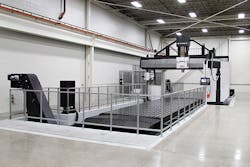Double-Column Machine Speeds Up Deep-Hole Drilling
Unisig — a Menomonee Falls, Wis. manufacturer of deep-hole drilling systems— recently added more large-scale production capacity by installing a new Okuma machine described as “the largest double-column machine of its type in North America.” It’s a fast-production route for processing complex components involved in assembling Unisig’s large-sized deep-hole drilling systems.
The Okuma MCR-A5CII-35x100 double-column machining center has multiple cutting heads that allow it to process five sides of a large part in a single setup. This means that Unisig will be able to manufacture high-quality parts for its systems more quickly, and at a lower cost than by cutting the parts in a more standard vertical machine.
Anthony Fettig, CEO at Unisig, said the MCR-A5CII-35x100 advances Unisig’s considerable engineering capabilities and promotes greater productivity as it addresses rising demand for its deep-hole drilling systems. “This machine allows us to keep semi-finished part production in-house and decreases labor intensive finishing work.”
The MCR-A5CII-35x100 is a high-speed machining center with compact auto loading/unloading attachments for true five-sided machining. Its rigid double-column construction will help Unisig achieve tight part tolerances that are required for the large-dimension systems it manufactures.
The Okuma machine has a 118x394-in. table; 61-ton weight capacity; and a 6,000-rpm 50-taper spindle to promote speedy production of large parts.
Safe and efficient part handling is effected by a radio-controlled, Konecranes® 50-ton bridge-style crane with a 40-foot span and 205-in. clearance (17-ft. 1 in.) To prepare for installing the new machine, Unisig modified its shop with a deep, specially engineered foundation that weighs 650 tons and has helical piers in the ground to support the combined weight of the machine and the 50-ton crane.
More broadly, Unisig is always looking for new ways to optimize its operations while adopting new technologies according to the expectations of its aerospace, automotive, defense, energy, and moldmaking customers.
“By investing in new production equipment, such as the Okuma machine, we can reduce our set-up times, improve throughput, and minimize costly production errors,” Fettig said, “all of which bring added value to our customers.”
About the Author
Robert Brooks
Content Director
Robert Brooks has been a business-to-business reporter, writer, editor, and columnist for more than 20 years, specializing in the primary metal and basic manufacturing industries.
